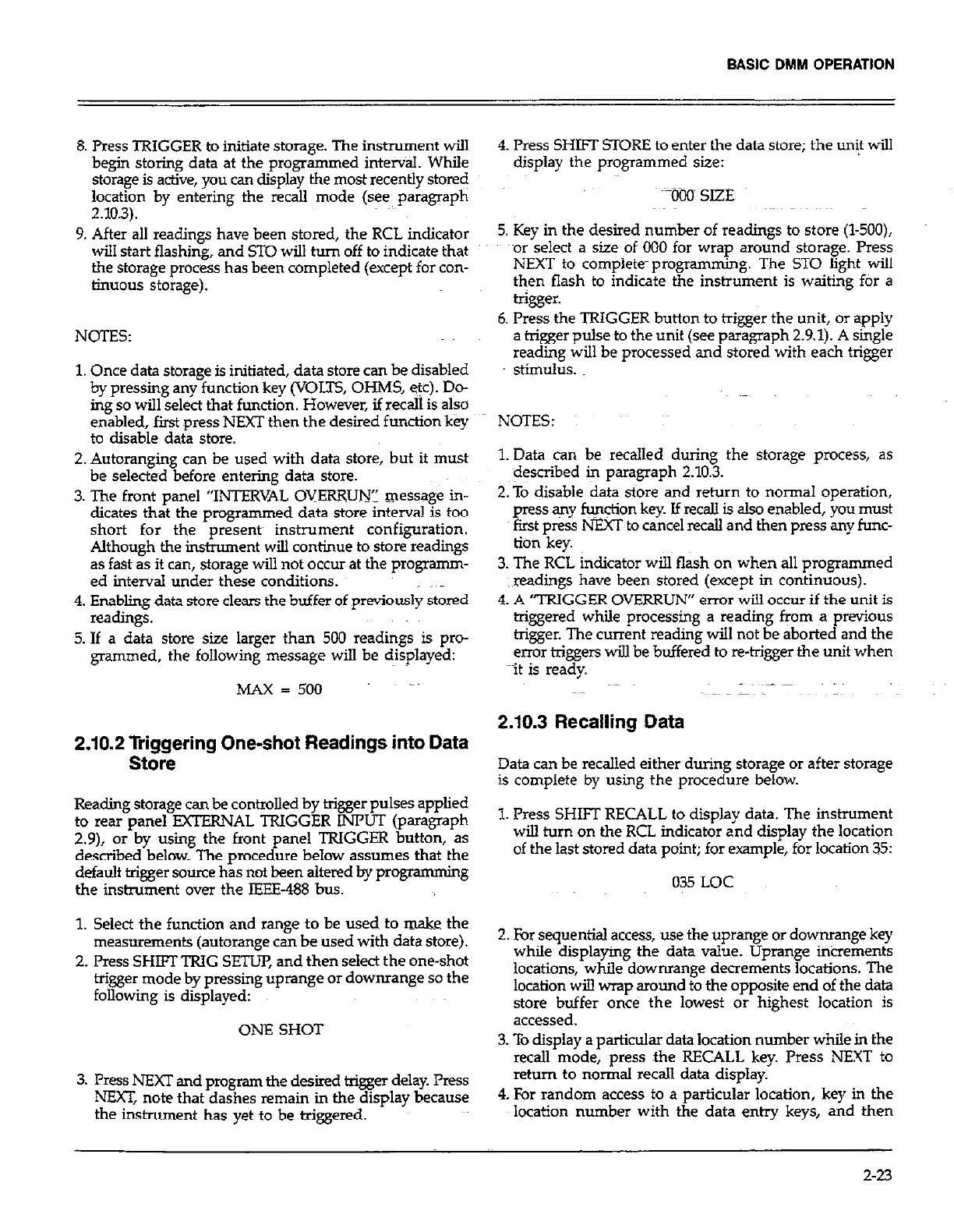BASIC DMM OPERATION
8. Press TRIGGER to initiate storage. The instrument will
4. Press SHIFI STORE to enter the data store; the uni’ will
begin storing data at the programmed interval. While display the programmed size:
storage is active, you can display the most recently stored
location by entering the recall mode (see paragraph
~~=o~oo SIZE
^ _^^~
L.IV.5,.
9~ Aftm all warlinm have heen stovz=cl the RCL indicator
. _-.__ -_. -----.‘~- _.-._ ___.. _.___ -,
5. Key in the desired number of readings to store (l-500),
will start &shine. and ST0 will turn
..~.._, ~-~- - -- -~ ~~~~~ off to indicate that
nor select a size of 000 for wrap around storage. Press
the si borage process has been completed (except for con-
NEXT to complete- programming. The ST0 light will
tinuous storaee).
then flash to indicate the instrument is waiting for a
trigger.
6. Press the TRIGGER button to trigger the unit, or apply
a trigger pulse to the unit (see paragraph 2.9.1). A single
reading will be processed and stored with each trigger
1. Once data storage is initiated, data store can be disabled
stimulus.
by pressing any function key (VOLTS, OHMS, etc). Do-
ing so will select that function. However, if recall is also
enabled, fit press NEXT then the desired function key
~~ NOTES: :
to disable da& store.
2. Autoranging can be used with data store, but it must
be selecte~d before entering data store.
3. The front panel “INTERVAL OVERRUN’! message in-
dicates that the programmed data store interval is too
short for the presents instrument configuration.
Although the instrument will continue to store readings
as fast as it can, storage will not occur at the programm-
ed interval under these conditions.
4. Enabling data store clears the buffer of previously stored
readings.
5. If a data store size larger than 500 readings is pro-
grammed, the following message will be d~isplayed:
MAX = 500
2.10.2 Triggering One-shot Readings into Data
Store
1. Data can be recalled during the storage process, as
redescribed in paragraph 2.10.3.
2. To disable data store and return to normal operation,
press +y hqion key. If recall is also enabled, you must
first press NEXT to cancel recall and then press any iimc-
tion key.
3. The RCL indicator will flash on when all programmed
..readings have been stored (except in continuous).
4. A ‘ll?IGGER OVERRUN” error will occur if fhe unit is
triggered while processing a reading from a previous
trigger. The current reading will not be aborted and the
error triggers will be buffered to re-trigger the unit when
?t is ready.
.~~
2.10.3 Recalling Data
Data can be recalled either during storage or after storage
is complete by using the procedure below.
Reading storage can be controlled by trigger pulses applied
to rear panel EXTERNAL TRIGGER INPUT (paragraph
1. Press SHIFT RECALL to display data. The instrument
iALL to display data. ~Ihe instrument
2.9), or by using the front panel TRIGGER button, as
will turn on the RCL indicator and display the location
?.CL indicator and display the location
described below. The procedure below assumes that rhe
of the last stored data point; for example, for location 35:
data point; for example, for location 35:
default triaer source his not been altered by programming
the instrument over the IEEE-488 bus.
1. Select the function and range to be used to make the
measurements (autorange can be used with data store).
2. For sequential access, use the uprange or downrange key
2. Press SHLFTti
[G SETLTF, and then select the one-shot
while displaying the data value. Uprange intiements
trigger mode by pressing uprange or downrange so the
locations, while downrange decrements locations. The
following is displayed:
location will wrap around to the opposite end of the data
store buffer once the lowest or highest location is
ONE SHOT
accessed.
3. To display a particular data location number while in ihe
recall mode, press the RECALL key. Press NEXT to
3. Press NEXT and pmgram the desired trigger delay. Press
return to normal recall data display.
NE- note that dashes remain in the display because
4. For random access to a particular location, key in the
the instrument has yet to be triggered.
location number with the data entry keys, and then
2-23
